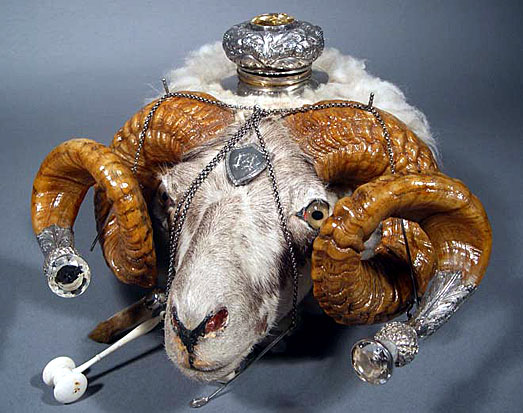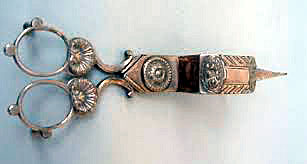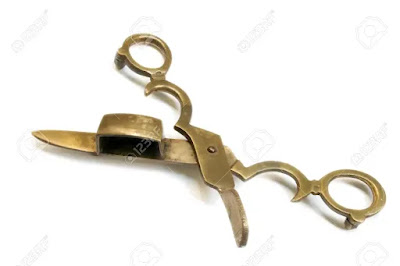 QUESTION: I’ve been fascinated by antique snuff boxes for some time. Most are a bit above my budget, but I’d like to purchase one or two soon. However, I know little about snuff and the origins of these decorative little containers. When did people start taking snuff? And where and where were the first snuff boxes made?
QUESTION: I’ve been fascinated by antique snuff boxes for some time. Most are a bit above my budget, but I’d like to purchase one or two soon. However, I know little about snuff and the origins of these decorative little containers. When did people start taking snuff? And where and where were the first snuff boxes made?
ANSWER: Snuff was a type of smokeless tobacco made from finely ground or pulverized tobacco leaves. Users snorted or "sniffed" it into their nasal cavity by inhaling it lightly after placing a pinch of it either onto the back of their hand, by pinching some between their thumb and index finger, or holding a specially made "snuffing" device.
 Friar Ramón Pane, a missionary who came to the New World with Christopher Columbus in 1493, was the first European to witness the inhaling of snuff by the Taino people of Haiti. Until then, tobacco was unknown to Europeans. But by the 1650s, artisans were making small boxes the snuff dry.
Friar Ramón Pane, a missionary who came to the New World with Christopher Columbus in 1493, was the first European to witness the inhaling of snuff by the Taino people of Haiti. Until then, tobacco was unknown to Europeans. But by the 1650s, artisans were making small boxes the snuff dry.
Traditional snuff production consisted of a lengthy, multi-step process, in tobacco snuff mills. The selected tobacco leaves were first cured or fermented, which gave it the individual characteristics and flavor for each type of snuff blend. Many blends of snuff required months to years of special storage to reach the required maturity. Fine snuff consisted of varieties of blended tobacco leaves without the addition of scents. Varieties of spice, piquant, fruit, floral, and mentholated soon followed, either pure or in blends.
 Each snuff manufacturer usually had a variety of unique recipes and blends, as well as special recipes for individual customers. Common flavors also included coffee, chocolate, Bordeaux wine, honey, vanilla, cherry, orange, apricot, plum, camphor, cinnamon, rose and spearmint.
Each snuff manufacturer usually had a variety of unique recipes and blends, as well as special recipes for individual customers. Common flavors also included coffee, chocolate, Bordeaux wine, honey, vanilla, cherry, orange, apricot, plum, camphor, cinnamon, rose and spearmint.
The 18th century witnessed an increase in the use of snuff, especially among the English and French aristocracy. Because it was a small, fine substance, it needed a vessel to contain it. Both snuff and the little boxes that contained it became important expressions of class. Originally made for daily use, snuff boxes became important symbols of personal representation. Snuff taking had become an important marker of social status.
 Although men could ingest other forms of tobacco, both men and women could take snuff. Tobacco would often be used by men while socializing in coffeehouses, thus becoming linked to public masculinity.
Although men could ingest other forms of tobacco, both men and women could take snuff. Tobacco would often be used by men while socializing in coffeehouses, thus becoming linked to public masculinity.
Taking snuff could be unpleasant, especially if there were a crowd in a room. In the act of ingesting it, a person had to remain dignified. Society considered it rude for snuff takers to make excessive noise making or reaction. Like tea or coffee consumption at this time, it wasn’t only about the substance being ingested: but the ingestion itself that had to adhere to society’s rule.
 The manufacture of snuff boxes became a lucrative industry when taking snuff was fashionable. Snuff boxes ranged from those made of horn to ornate designs featuring precious materials made using state-of-the-art techniques. Since prolonged exposure to air caused snuff to dry out and lose its quality, manufacturers designed snuff boxes to be airtight containers with strong hinges, generally large enough to hold a day's worth of snuff. The wealthy kept larger snuff containers, called mulls, on their dinner tables for use at dinner parties. These could be quite elaborate and often included rams horns decorated with silver or in some cases a depiction of the head of a ram.
The manufacture of snuff boxes became a lucrative industry when taking snuff was fashionable. Snuff boxes ranged from those made of horn to ornate designs featuring precious materials made using state-of-the-art techniques. Since prolonged exposure to air caused snuff to dry out and lose its quality, manufacturers designed snuff boxes to be airtight containers with strong hinges, generally large enough to hold a day's worth of snuff. The wealthy kept larger snuff containers, called mulls, on their dinner tables for use at dinner parties. These could be quite elaborate and often included rams horns decorated with silver or in some cases a depiction of the head of a ram.
 In the early 18th century, French jewelers created snuff boxes of gold set with diamonds, amethysts, and sapphires. By 1740, specialized artisans took over the production of these ornate tabatières, which they engraved, chased, and enameled.
In the early 18th century, French jewelers created snuff boxes of gold set with diamonds, amethysts, and sapphires. By 1740, specialized artisans took over the production of these ornate tabatières, which they engraved, chased, and enameled.
 The shapes of these boxes weren’t limited to rectangular boxes. Porcelain containers resembling little trunks were popular, as were ovals, but tabatières shaped like shells were more rare. And while the materials used to construct a box were often enough for its decoration, sometimes artisans hand painted these snuff boxes, depicting everything from miniature landscapes and bucolic scenes to tiny portraits or cameos of their owners.
The shapes of these boxes weren’t limited to rectangular boxes. Porcelain containers resembling little trunks were popular, as were ovals, but tabatières shaped like shells were more rare. And while the materials used to construct a box were often enough for its decoration, sometimes artisans hand painted these snuff boxes, depicting everything from miniature landscapes and bucolic scenes to tiny portraits or cameos of their owners.
Miniatures often adorned the lids of snuff boxes. These could be scenes from various mythological, Biblical, or pastoral settings, but portraiture was the most common decoration, especially on those boxes given as gifts. It was usually men who adorned the portraiture present on the jewelry of women.
 Silver snuff boxes became associated with Sheffield, England, where silver-plating had been perfected on these small containers in the late 18th century. By the early 19th century, the silver industry had blossomed in Birmingham, England, where snuff box makers such as Samuel Pemberton, Nathaniel Mills, and Edward Smith produced oblong containers with images of castles and abbeys on their tops and sides.
Silver snuff boxes became associated with Sheffield, England, where silver-plating had been perfected on these small containers in the late 18th century. By the early 19th century, the silver industry had blossomed in Birmingham, England, where snuff box makers such as Samuel Pemberton, Nathaniel Mills, and Edward Smith produced oblong containers with images of castles and abbeys on their tops and sides.
 Birmingham was also a center for papier-mâché snuff boxes, which manufacturers hardened using several layers of enamel. A market for these inexpensive boxes developed in the United States, so Birmingham box makers began decorating their wares with portraits of U.S. naval heroes and victory scenes from the War of 1812, often using engravings by such renowned American artists as Gilbert Stuart as their source material.
Birmingham was also a center for papier-mâché snuff boxes, which manufacturers hardened using several layers of enamel. A market for these inexpensive boxes developed in the United States, so Birmingham box makers began decorating their wares with portraits of U.S. naval heroes and victory scenes from the War of 1812, often using engravings by such renowned American artists as Gilbert Stuart as their source material.
To read more articles on antiques, please visit the Antiques Articles section of my Web site. And to stay up to the minute on antiques and collectibles, please join the over 30,000 readers by following my free online magazine, #TheAntiquesAlmanac. Learn more about "The Art Deco World" in the 2024 Spring Edition, online now. And to read daily posts about unique objects from the past and their histories, like the #Antiques and More Collection on Facebook.












